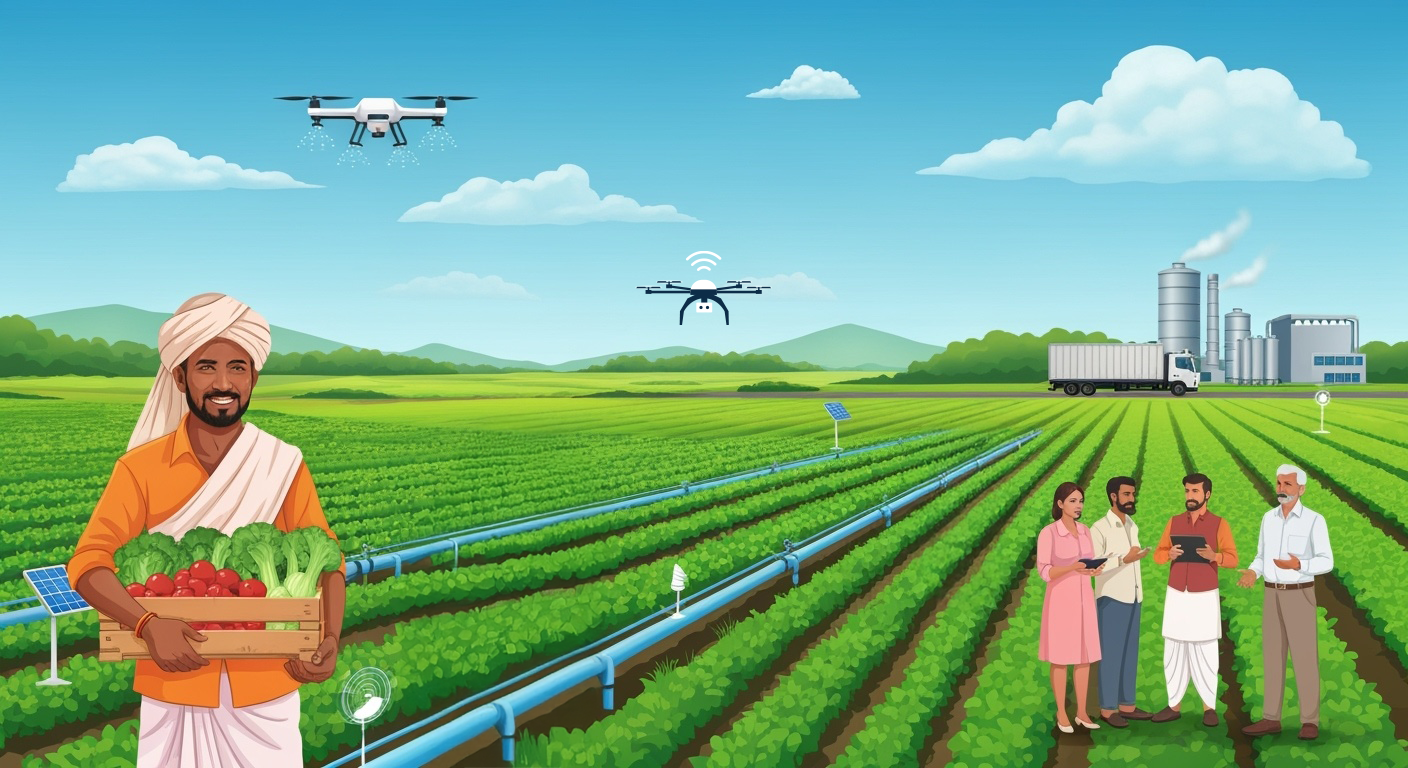India is an agricultural superpower. For as long as most of us can remember, agriculture has been an integral part of India's identity. It is especially prevalent in rural India, where 45.8% of the workforce relies on agriculture as their primary means of income.1 Tech like apps, AI, and automation has also impacted agriculture.
The past few years have brought a new ally to the field: technology. Not the tech we associate with Silicon Valley, but technology addressing immediate problems on the ground. It is emerging from every angle and is equally sustainably sourced, from startups and local entrepreneurs to government subsidy schemes, offering a multitude of options and entrepreneurial opportunities.
The result is a significant difference between how rural India farms and how it earns its income. Preconditions that would traditionally take a decade to implement have been achieved in just a few years. Execution at scale will determine outcomes, but early pilots are promising. In the past three years, the Agritech sector has experienced historic 10x growth, driven by four key factors: increasing digital penetration across India, supply chain disruptions caused by COVID-19, growing consumer preferences for quality produce, and increased interest from private equity and venture capital. 2
As of December 2023, India had over 2,800 DPIIT-recognised agritech startups.3 These startups are often referred to as "a ray of hope" and are innovating and transforming the way agricultural work has traditionally been carried out in India. Here are several ways in which AgriTech startups are changing the landscape.
1. Precision farming: Making every drop and seed count
One of the leading areas in which AgriTech startups are making a major contribution is precision farming. Precision farming enables the more accurate application of resources such as water, fertilisers, and pesticides, thereby increasing efficiency and reducing environmental impacts. This not only has the potential to improve crop yields by up to 30% but also promotes a sustainable form of farming, which is especially important with the onset of climate change.4 According to industry estimates, precision farming can improve yields by 20–30% and reduce input costs by 15–20%, especially in high-value crops like fruits and vegetables.5 For example, Fasal Tech uses real-time data and science to help farmers make informed decisions in their fields. To provide farmers with accurate, practical guidance on five key areas - irrigation, disease management, pest control, fertiliser use, and climate risk management - they have developed a clever mix of IoT, AI, and agronomy. Their IoT device, Fasal Sense, collects data directly from the field and is at the centre of it. A central system then processes this data alongside inputs from radar and satellites, analysing and interpreting it to provide farmers with valuable information guidance.6
2. Drone technology: Aerial solutions for ground-level issues
Drones are rapidly becoming one of the most innovative technologies in India’s agricultural sector. From monitoring and imaging crops to spraying pesticides and estimating yields, drones are enhancing efficiency and safety.
To achieve fast-tracked adoption of agricultural practices, the government has launched initiatives such as “Namo Drone Didi,” which aims to train 15,000 women-led SHGs in rural areas to become licensed drone operators.7
Research has shown that drone spraying technology can cut the use of crop protection chemicals by up to 30%, while also reducing farmers' exposure to pesticides during spraying. It can also cover larger areas of growing environments in a fraction of the time. 8
3. Climate-resilient crops: Adapting to a changing future
Extreme weather events now pose a greater threat to crop security as droughts, floods, and heatwaves become more frequent. Consequently, both public and private organisations are investing resources into developing climate-resilient seed varieties capable of withstanding stress without sacrificing yield.
Under the Indian Council of Agricultural Research (ICAR), the National Agricultural Research System (NARS), which comprises ICAR Institutes and State/Central Agricultural Universities (CAU/SAU), has developed 2,900 location-specific improved field crop varieties/hybrids between 2014 and 2024. These include 1,380 cereals, 412 oilseeds, 437 pulses, 376 fibre crops, 178 forage crops, 88 sugarcane, and 29 other crops.9 The Government of India is implementing the Seed Village Programme component of the Sub-Mission on Seed and Planting Material (SMSP) under the National Food Security and Nutrition Mission to make seeds of climate-resilient, biofortified, and high-yielding varieties available to farmers at the village level.10
Aside from that, many scientists are currently working to develop more intelligent methods of crop improvement that will help them better withstand the effects of climate change. To produce crops that can endure heat, drought, and pests, they are using cutting-edge techniques. Meanwhile, farmers are making better decisions in the field thanks to technologies like artificial intelligence (AI) and satellite data, which assist them in maximising the potential of these climate-resilient crops. There are also startups such as Farmtheory that focus on reducing agricultural waste, helping farmers earn more while addressing climate change.
4. Agri-logistics: Bridging the last-mile gap
With an average of 55 kg of food waste generated per capita annually by households, the total food waste generated in India is about 78 million tonnes.11 The estimated cost of India’s food waste is up to ₹92,000 crores every year.12
New logistics models are complementing traditional supply chains and raising service benchmarks. Agri-tech startups now focus on the logistics of agriculture, including cold chains, micro-warehouses, and efficient farm-to-market links. Companies like Arya.ag and DeHaat are developing systems that enable farmers to securely store their produce, access loans based on their warehouses, and reduce distress selling. .
5. AgriStack & Digital Agriculture Mission: Building the data backbone
At a systems level, India is advancing its digital infrastructure for agriculture through initiatives like the AgriStack and Digital Agriculture Mission.13
By establishing the user's agricultural identification and linking it with land records, cropping patterns, and soil health, a user-centric framework has the potential to provide targeted subsidies, credit, insurance, and advisories, eliminating manual paperwork in future.
With 19 states having signed MoUs with the Ministry of Agriculture, the central and state governments are collaborating to advance the implementation of AgriStack. To test the development of Farmer IDs and the Digital Crop Survey, pilot projects have been conducted in six states, including Uttar Pradesh, Gujarat, and Maharashtra.14
With e-NAM already connecting over 1,522 mandis across 23 states and four union territories, the digital plan is helping to make India's agriculture more transparent, inclusive, and sustainable, regardless of phase or form of activity.15
Conclusion: An Innovative Future
In India, integrating technology with agriculture not only increases output but also supports millions of people whodepend on it to achieve sustainability, opportunity, and dignity. Platforms like AgroStar (inputs/advisory) and DeHaat (inputs + market linkages) help farmers buy quality inputs and access advisory, and connect produce to institutional buyers.
Agri-tech can build a more resilient and dynamic rural economy by transforming farmers into entrepreneurs, helping themadapt quickly, and ultimately boosting resilience for their collective benefit. As startups, policies, and communities continue to expand, it is clear that the vision of a Digital Bharat rooted in its fields but prepared for the future is no longer just a hope. It is already taking shape.

